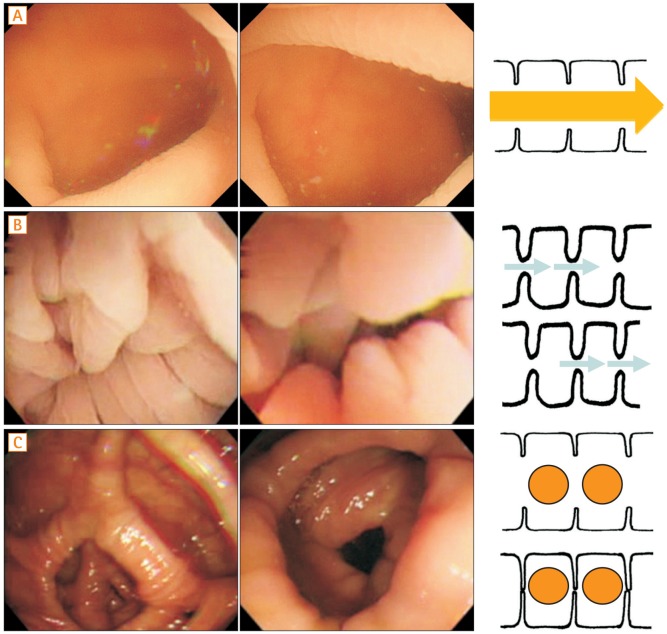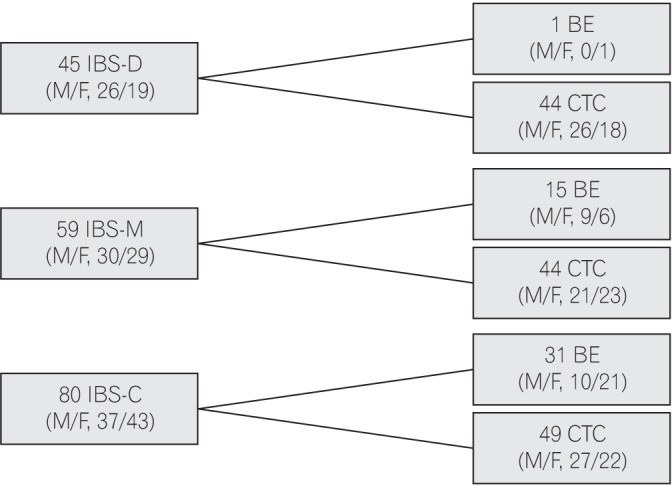Intest Res.
2017 Apr;15(2):236-243. 10.5217/ir.2017.15.2.236.
Colonic dysmotility and morphological abnormality frequently detected in Japanese patients with irritable bowel syndrome
- Affiliations
-
- 1Endoscopy Center, NHO Kurihama Medical and Addiction Center, Yokosuka, Japan. mi-zukami@violin.ocn.ne.jp
- 2Division of Gastroenterology and Hepatology, Department of Internal Medicine, Keio University School of Medicine, Tokyo, Japan.
- 3Medical Education Center, Keio University School of Medicine, Tokyo, Japan.
- KMID: 2425167
- DOI: http://doi.org/10.5217/ir.2017.15.2.236
Abstract
- BACKGROUND/AIMS
Colonoscopy and computed tomography (CT) are used primarily to exclude organic diseases in patients with irritable bowel syndrome (IBS), rather than to assess the pathophysiology of IBS. We aimed to evaluate colonic dysmotility and morphology in Japanese patients with IBS.
METHODS
One hundred eighty-four patients with IBS and 49 asymptomatic controls who underwent colonoscopy in combination with CT colonography or barium enema were retrospectively reviewed between 2008 and 2012. Water-aided colonoscopy was performed without sedation by a single endoscopist. The duration and pattern of colonic movement and cecal intubation time were recorded. To assess colonic morphology, barium enema or CT colonography were performed immediately after colonoscopy.
RESULTS
Colonic dysmotility was more frequent in the IBS group (28.8% vs. 2.0% in controls, P<0.001), especially in cases of IBS with diarrhea (IBS-D) (IBS with constipation [IBS-C] 28.8% vs. IBS-D 60.0% vs. mixed IBS [IBS-M] 5.1%, P<0.001). Colonic morphological abnormality was more frequent in the IBS group than in the control group (77.7% vs. 24.5%, P<0.001), especially in IBS-M and IBS-C groups (IBS-C 77.5% vs. IBS-D 48.9% vs. IBS-M 100%, P<0.001). Most patients with IBS with colonic dysmotility had experienced stress related to their symptoms. Cecal intubation time was significantly longer in the IBS group than in the control group (12.1±6.9 minutes vs. 4.6±1.9 minutes, P<0.001).
CONCLUSIONS
Unsedated colonoscopy, combined with radiographic findings, can detect colonic dysmotility and morphological abnormality. Technical difficulties observed during cecal intubation may partially explain the pathophysiology of IBS.
MeSH Terms
Figure
Reference
-
1. Gralnek IM, Hays RD, Kilbourne A, Naliboff B, Mayer EA. The impact of irritable bowel syndrome on health-related quality of life. Gastroenterology. 2000; 119:654–660. PMID: 10982758.
Article2. Drossman DA. The functional gastrointestinal disorders and the Rome III process. Gastroenterology. 2006; 130:1377–1390. PMID: 16678553.
Article3. Lovell RM, Ford AC. Global prevalence of and risk factors for irritable bowel syndrome: a meta-analysis. Clin Gastroenterol Hepatol. 2012; 10:712–721.e4. PMID: 22426087.
Article4. Fukudo S, Suzuki J. Colonic motility, autonomic function, and gastrointestinal hormones under psychological stress on irritable bowel syndrome. Tohoku J Exp Med. 1987; 151:373–385. PMID: 3617051.
Article5. Kim ES, Cheon JH, Park JJ, et al. Colonoscopy as an adjunctive method for the diagnosis of irritable bowel syndrome: focus on pain perception. J Gastroenterol Hepatol. 2010; 25:1232–1238. PMID: 20594249.
Article6. Spiller R, Aziz Q, Creed F, et al. Guidelines on the irritable bowel syndrome: mechanisms and practical management. Gut. 2007; 56:1770–1798. PMID: 17488783.
Article7. Lee KJ, Tack J. Altered intestinal microbiota in irritable bowel syndrome. Neurogastroenterol Motil. 2010; 22:493–498. PMID: 20414959.
Article8. Gwee KA, Collins SM, Read NW, et al. Increased rectal mucosal expression of interleukin 1beta in recently acquired postinfectious irritable bowel syndrome. Gut. 2003; 52:523–526. PMID: 12631663.
Article9. Gonsalkorale WM, Perrey C, Pravica V, Whorwell PJ, Hutchinson IV. Interleukin 10 genotypes in irritable bowel syndrome: evidence for an inflammatory component? Gut. 2003; 52:91–93. PMID: 12477767.
Article10. Chey WY, Jin HO, Lee MH, Sun SW, Lee KY. Colonic motility abnormality in patients with irritable bowel syndrome exhibiting abdominal pain and diarrhea. Am J Gastroenterol. 2001; 96:1499–1506. PMID: 11374689.
Article11. Mizukami T, Horiuchi Y, Mori N, et al. Endoscopic evaluation of colonic movement after the administration of a spasmolytic drug to irritable bowel syndrome patients: application to diagnosis and therapy. J Psychosom Digest Dis. 2009; 16:91–97.12. Mizukami T, Yokoyama A, Imaeda H, Kumai K. Collapse-submergence method: simple colonoscopic technique combining water infusion with complete air removal from the rectosigmoid colon. Dig Endosc. 2007; 19:43–48.
Article13. Mizukami T, Hibi T. How I teach my trainees “water navigation colonoscopy”. Am J Clin Med. 2010; 7:144–146.14. Asai S, Fujimoto N, Tanoue K, et al. Water immersion colonoscopy facilitates straight passage of the colonoscope through the sigmoid colon without loop formation: randomized controlled trial. Dig Endosc. 2015; 27:345–353. PMID: 25413483.
Article15. Sugimoto S, Mizukami T. Diagnostic and therapeutic applications of water-immersion colonoscopy. World J Gastroenterol. 2015; 21:6451–6459. PMID: 26074684.
Article16. Mizukami T, Ogata H, Hibi T. “Passive-bending colonoscope” significantly improves cecal intubation in difficult cases. World J Gastroenterol. 2012; 18:4454–4456. PMID: 22969214.
Article17. Khashab MA, Pickhardt PJ, Kim DH, Rex DK. Colorectal anatomy in adults at computed tomography colonography: normal distribution and the effect of age, sex, and body mass index. Endoscopy. 2009; 41:674–678. PMID: 19670134.
Article18. Weinberg DS, Smalley W, Heidelbaugh JJ, Sultan S. American Gastroenterological Association. American Gastroenterological Association Institute guideline on the pharmacological management of irritable bowel syndrome. Gastroenterology. 2014; 147:1146–1148. PMID: 25224526.
Article19. Fukudo S, Kaneko H, Akiho H, et al. Evidence-based clinical practice guidelines for irritable bowel syndrome. J Gastroenterol. 2015; 50:11–30. PMID: 25500976.
Article20. Bouin M, Plourde V, Boivin M, et al. Rectal distention testing in patients with irritable bowel syndrome: sensitivity, specificity, and predictive values of pain sensory thresholds. Gastroenterology. 2002; 122:1771–1777. PMID: 12055583.
Article21. Cullingford GL, Coffey JF, Carr-Locke DL. Irritable bowel syndrome: can the patient’s response to colonoscopy help with diagnosis? Digestion. 1992; 52:209–213. PMID: 1459355.
Article22. Shah SG, Brooker JC, Thapar C, Williams CB, Saunders BP. Patient pain during colonoscopy: an analysis using real-time magnetic endoscope imaging. Endoscopy. 2002; 34:435–440. PMID: 12048623.
Article23. Whitehead WE, Holtkotter B, Enck P, et al. Tolerance for rectosigmoid distention in irritable bowel syndrome. Gastroenterology. 1990; 98(5 Pt 1):1187–1192. PMID: 2323511.
Article24. Leung CW, Kaltenbach T, Soetikno R, Wu KK, Leung FW, Friedland S. Water immersion versus standard colonoscopy insertion technique: randomized trial shows promise for minimal sedation. Endoscopy. 2010; 42:557–563. PMID: 20593332.
Article25. Anderson JC. Water-aided colonoscopy. Gastrointest Endosc Clin N Am. 2015; 25:211–226. PMID: 25839683.
Article26. Sugimoto S, Hosoe N, Mizukami T, et al. Effectiveness and clinical results of endoscopic management of sigmoid volvulus using unsedated water-immersion colonoscopy. Dig Endosc. 2014; 26:564–568. PMID: 24533946.
Article27. Sugimoto S, Mizukami T, Ito T, et al. Endoscopic detorsion for sigmoid volvulus using unsedated water-immersion colonoscopy. Endoscopy. 2013; 45(Suppl 2):E263–E264. PMID: 24008457.
Article28. Saunders BP, Halligan S, Jobling C, et al. Can barium enema indicate when colonoscopy will be difficult? Clin Radiol. 1995; 50:318–321. PMID: 7743720.
Article29. Hanson ME, Pickhardt PJ, Kim DH, Pfau PR. Anatomic factors predictive of incomplete colonoscopy based on findings at CT colonography. AJR Am J Roentgenol. 2007; 189:774–779. PMID: 17885044.
Article
- Full Text Links
- Actions
-
Cited
- CITED
-
- Close
- Share
- Similar articles
-
- Dose Irritable Bowel Syndrome and Dysmotility Have an Autoimmune Origin? (Neurogastroenterol Motil 2011;23:1000-1006, e459)
- Irritable bowel syndrome
- Colonic transit time in irritable bowel syndrome
- Decreased Neuroplasticity May Play a Role in Irritable Bowel Syndrome: Implication From the Comorbidity of Depression and Irritable Bowel Syndrome
- Irritable Bowel Syndrome




